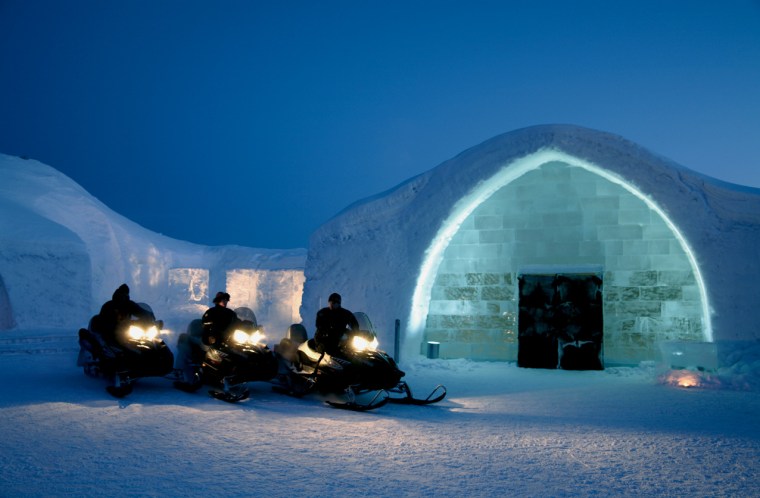I've never been a fan of the cold. As a kid, my favorite part of skiing was the hot chocolate, and I relished blizzards for the snow days, not the snowball fights. So when I booked a trip to the Icehotel in northern Sweden, my family and friends were amused — and a bit concerned, especially when I got sick days before my flight. "You can't go to the Arctic with a cold!" my mother admonished.
But I had good reason for wanting to sleep in a glorified freezer: As an environmental reporter, I was curious to see a place where people have turned snow and ice into a moneymaker, one that's spawned copycats in frigid spots from Canada to Romania.
Conceived by Yngve Bergqvist, a river-rafting guide who wanted to lure visitors to the Arctic north during the winter, the Icehotel started out in 1990 as nothing more than a crude igloo. Now, it's a fanciful ice castle that's rebuilt every November with an unparalleled level of artistry — which explains why each winter 16,000 guests pay hundreds of dollars a night to sleep on a slab of ice and thousands more make the trek just to tour the rooms for the day.
The 30 most elaborate suites are the handiwork of a team of artists — sculptors, painters, architects, even comic book illustrators — many of whom have never worked with ice before. Wielding chain saws and chisels, they spend weeks crafting frozen furniture while electricians install lights to provide an ethereal glow. Surreal? Exceedingly.
This winter, German furniture maker Jens Paulus and American industrial designer Joshua Space created a space-station room straight out of “Star Trek,” with giant carvings of the sun and moon on opposing walls and twinkling lights in the ceiling. British decorator Ben Rousseau and graffiti artist Insa devised the Getting Cold Feet suite, with oversize high-heeled ice shoes beside the bed. Twenty-nine unadorned snow caves offer a somewhat less pricey and more purist experience.
Since no hotel would be complete without a bar, the artists also sculpt a chic space where guests can warm their innards with an Icebar Jukkasjärvi, a mix of vodka, blueberry liqueur, blue curaçao syrup and elderflower juice, sipped from a cube-shaped ice glass. Then there's the chapel, where designs etched into the ice walls resemble stained glass. About 150 couples tie the knot here each year, some brides bundled in snowsuits, others dressed in white wedding gowns, their teeth chattering as they recite their vows.
When I arrive in Sweden, I'm surprised to find that the guests actually spend a lot of time in a pair of heated chalets that look like life-size gingerbread houses. The shower and bathroom are located in the one nearest the hotel — because, really, who wants to sit on a frozen throne?
And the other contains the restaurant, where chef Richard Näslin dreams up such intriguing dishes as arctic char ice cream, which has a slightly salty, smoky flavor and is much more delicious than it sounds. After my dinner, wrapped in several layers of fleece and down, I waddle out to a tepee for a folk concert by native Laplander Yana Mangi. At the end of each song, the crowd responds with a uniquely Arctic ovation: muffled mitten clapping.
My suite has a nautical theme, with walls curved into a frozen wave and an oval bed of bluish ice set beneath a clam-shaped headboard. Topped with a mattress and a reindeer skin, the setup looks snug. Almost. The temperature is a brisk 23 degrees Fahrenheit, and I'm still petrified I'll lose a finger to hypothermia, even in my head-to-toe winter wardrobe.
I climb under the furry blanket, making sure not an inch of skin is exposed. Then I gaze through the slits in my microfleece face mask and marvel at the stillness. My breath comes in shallow white puffs. Soon, I'm fast asleep.
The next thing I know, a hotel attendant is standing beside me with a cup of steaming lingonberry juice — my wake-up call. Amazingly, I slept through the night, giving new meaning to the expression "out cold." I wiggle my fingers and toes — they're tingly, but all there. Then I do what any sane person would: sprint to the chalet to thaw out in the shower and sauna.
Most guests stay only one night, but I opt for a second. It's not to prove my mettle; I feel as if I've done that. Rather, I find my frosty alcove incredibly restful and therapeutic. Maybe the hotel should add an ice yoga studio next?
Jukkasjärvi, 11 miles from Kiruna, 011-46/980-66-800, icehotel.com, from $400 for a snow room, from $535 for an art suite, both include breakfast and sauna.
Getting there
A round-trip flight between New York and Stockholm on SAS costs about $700 in midwinter (flysas.com). From Stockholm, take a 16-hour train ride to Kiruna (from $44 round trip). The Icehotel is a $13 bus ride away.
When to go
The hotel opens every year in early December and closes at the end of April. You have a chance of spotting the northern lights in December and January, but those are the coldest months — temperatures can dip to 45 below.
What to pack
Think wool and fleece layers; avoid cotton, which can trap moisture and make you colder. The hotel supplies boots and hats. For details, see icehotel.com/winter/adventure/dress.
Where to splurge
Don't miss the guided hotel tour ($37 per person). And how about an ice-sculpting lesson ($75 per person)? Or a six-hour snowmobile safari to see moose at their winter feeding grounds ($400 per person)?
Where to save
Tour the Icehotel by day, and then spend the night at Hotel Kebne in Kiruna (011-46/980-68-180, hotellkebne.com, from $100).
